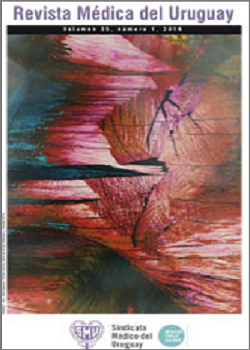Historical evolution of the mortality in burned patient at the Centro Nacional de Quemados (National Burns Center) between 1995 and 2017
Abstract
Introduction:
burned patients mortality has decreased because of a better understanding of initial shock pathophysiology, early surgical interventions, antibiotic therapy optimization and appropriate nutritional support. Mortality reduction has also been related to the creation of specialized burn centers. There are no recent reports of burn injury patients in our country.
Objective:
to describe characteristics and evolution of patients assisted at the national burned center (Centro Nacional de Quemados, Uruguay).
Methods:
transversal, observational, descriptive study. All patients admitted in the center with diagnosis of skin burns or inhalation injury, from the center’s opening in 1995 through December 31, 2017.
Results:
during the study period 3,050-burned patients were admitted, 25% of which had a total body surface area burnt of at least 20%. There was a predominance of male sex (62%) and young patients (more than 60% had less than 50 years old). The most frequent responsible agent was direct fire (71%), followed by hot liquids (9%) and electricity (5%). Mechanical ventilation was needed in 43% of the patients, and mean length of stay in the center was 17 days. Overall mortality rate was 19.7%, accordingly to that predicted by specific severity scores. In the sub-group of more severe patients, mortality has progressively decreased since the center opening.
Conclusions:
our center assists young patients with burn injuries mostly caused by direct fire. Overall mortality is in line with the expected according to severity scores, having decreased progressively since the center inauguration.
References
(1) Peck MD. Epidemiology of burns throughout the world. Part I: Distribution and risk factors. Burns 2011; 37:1087-100.
(2) Citron I, Amundson J, Saluja S, Guilloux A, Jenny H, Scheffer M, et al. Assessing burn care in Brazil: an epidemiologic, cross-sectional, nationwide study. Surgery 2018; 163(5):1165-72.
(3) Mason SA, Nathens AB, Byrne J, Gonzalez A, Fowler R, Karanicolas P, et al. Trends in the epidemiology of major burn injury among hospitalized patients: a population-based analysis. J Trauma Acute Care Surg 2017; 83:867-74.
(4) Mason SA, Nathens AB, Byrne JP, Fowler RA, Karanicolas PJ, Moineddin R, et al. Burn center care reduces acute health care utilization after discharge: a population-based analysis of 1,895 survivors of major burn injury. Surgery 2017; 162:891-900.
(5) Tobiasen J, Hiebert JM, Edlich RF. The abbreviated burn severity index. Ann Emerg
Med 1982; 11:260-2.
(6) Cabrera J, Baz M, Alzugaray P, Echavarría E, Vanerio J, Juri H. Epidemiología del Centro Nacional de Quemados del Uruguay. Rev Arg Quemaduras 2010; 1:13-9.
(7) Davé DR, Nagarjan N, Canner JK, Kushner AL, Stewart BT. Rethinking burns for low & middle-income countries: differing patterns of burn epidemiology, care seeking
behavior, and outcomes across four countries. Burns 2018; 44(5):1228-34.
(8) Roberts I. cause specific social class mortality differentials for child injury and poisoning in England and Wales. J Epidemiol Community Health 1997; 51:334-5.
(9) Bertullo M, Carbone N, Brandes M, Silva M, Meiss H, Tejera D, et al. Epidemiología, diagnóstico y tratamiento de la sepsis severa en Uruguay: un estudio multicéntrico
prospectivo. Rev Méd Urug 2016; 32:177-89.
(10) Cheng W, Yan-hua R, Fang-gang N, Wei-li D, Guo-an Z. Epidemiology of 1974 burn patients at a major burn center in Beijing: a nine-year study. J Burn Care Res 2012;
:e228-33.
(11) Hosseini S, Rashtchi V, Kamali K, Moghimi M. Epidemiology and outcome of 2590 burned patients in Northwest Iran. Ann Burns Fire Disasters 2017; 30(2):85-90.
(12) Sheridan RL. Burn care: results of technical and organizational progress. JAMA 2003; 290:719-22.
(13) Mason SA, Nathens AB, Byrne J, Gonzalez A, Fowler R, Karanicolas P, et al. Trends in the epidemiology of major burn injury among hospitalized patients: a population-based analysis. J Trauma Acute Care Surg 2017; 83:867-74.
(14) Ehrl D, Heidekrueger P, Ninkovic M, Broer PN. Effect of primary admission to burn centers on the outcomes of severely burned patients. Burns 2018; 44(3):524-30.
(15) Dres M, Austin PC, Pham T, Aegerter P, Guidet B, Demoule A, et al. Acute respiratory distress syndrome cases volume and ICU mortality in medical patients. Critical Care Med 2018; 46(1):e33–e40.
(16) Lecuyer L, Chevret S, Guidet B, Aegerter P, Martel P, Schlemmer B, et al. Case volume and mortality in haematological patients with acute respiratory failure. Eur Respir J 2008; 32:748-54.
(17) Vincent JL, Lefrant JY, Kotfis K, Nanchal R, Martin-Loeches I, Wittebole X, et al. Comparison of European ICU patients in 2012 (ICON) versus 2002 (SOAP). Intensive Care Med 2018; 44:337-44.













